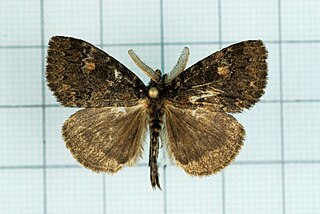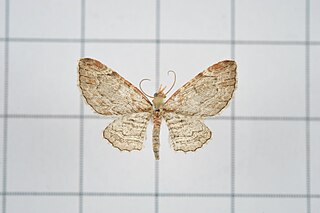
Eilema is a genus of moths in the subfamily Arctiinae. The genus was erected by Jacob Hübner in 1819.

Hypsopygia costalis, the gold triangle or clover hay moth, is a species of moth of the family Pyralidae. It was described by Johan Christian Fabricius in 1775 and is found in Europe. The wingspan is 16–23 mm. The adult moths fly from May to July, depending on the location. The supposed species H. aurotaenialis is included here pending further study.

Manulea is a genus of moths in the family Erebidae erected by Hans Daniel Johan Wallengren in 1863. The type species is Lithosia gilveola Ochsenheimer, 1810.
Zadadra is a genus of moths in the subfamily Arctiinae.

Euzora is a genus of moths in the subfamily Lymantriinae. The genus was described by Turner in 1915.

Ilema is a genus of tussock moths in the family Erebidae. The genus was described by Walker in 1855 and renamed by Moore in 1860, because Walker's chosen name was preoccupied.

Asthenotricha is a genus of moths in the family Geometridae.

Hydrelia is a genus of moths in the family Geometridae erected by Jacob Hübner in 1825.

Philodoria is a genus of moths in the family Gracillariidae. All species are endemic to Hawaii. It was first described by Lord Walsingham in 1907.
Anoratha costalis is a moth of the family Erebidae first described by Frederic Moore in 1867. It is found in northern India.

Habrosyne is a genus of moths belonging to the family Drepanidae. It was first described by Jacob Hübner in 1816.
Aloa costalis is a moth that belongs to the family Erebidae. It was described by Francis Walker in 1865. It is found in north-eastern Australia.

Eupithecia costalis is a moth in the family Geometridae first described by Francis Walker in 1863. It is widespread in the tropical and subtropical lowland regions of east and south-east Asia, from Taiwan to India, Sri Lanka Borneo, to Hong Kong.
Asthenotricha costalis is a moth in the family Geometridae first described by Per Olof Christopher Aurivillius in 1910. It is found in Kenya and Tanzania.
Manulea costalis is a moth of the family Erebidae. It is found in Albania, Bulgaria, Serbia, North Macedonia, Greece and on Crete, as well as in Turkey and Armenia. on the Andamans and from India to Myanmar.
Zadadra distorta is a moth of the subfamily Arctiinae. It is found in Nepal, India and Pulau Laut.
Zadadra fuscistriga is a moth of the subfamily Arctiinae. It is found in Myanmar and Assam, India.

Euzora costalis is a moth of the subfamily Lymantriinae first described by Frederic Moore in 1879. It is found in Sikkim, India.
Pheia costalis is a moth in the subfamily Arctiinae. It was described by Rothschild in 1911. It is found in Bolivia.
Lacida costalis is a moth of the family Erebidae first described by Francis Walker in 1855. It is found in Sri Lanka.









